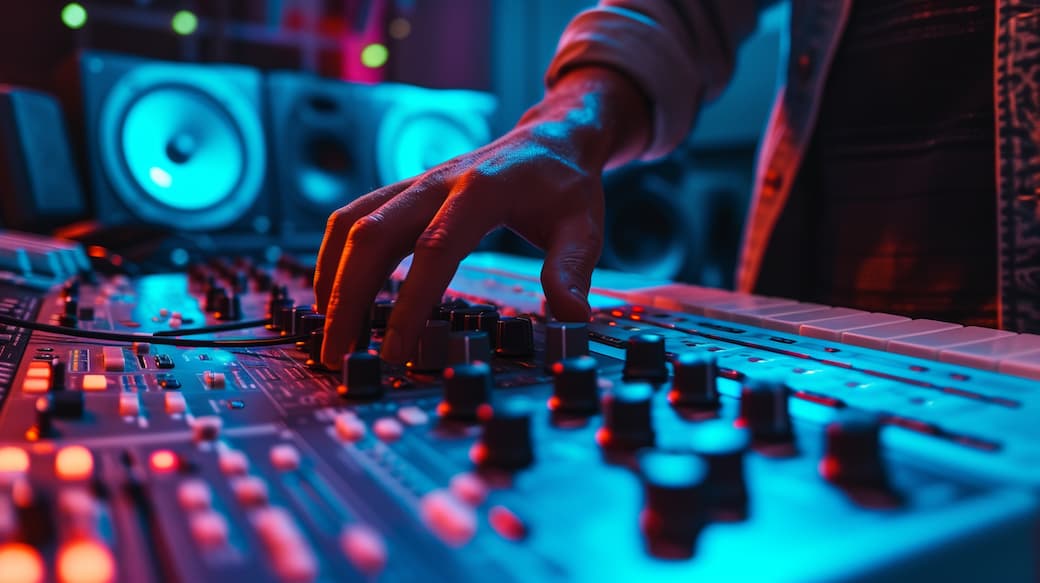
Spatial Computing Sound Experiences with Apple’s RealityKit Audio – VRTONUNG – Virtual Reality Sound
Content
In the dynamic world of extended reality and spatial computing experiences, audio stands as a transformative element, essential for creating immersive environments.
Apple’s RealityKit, a cornerstone in augmented reality development, offers a powerful platform for integrating spatial audio, significantly enhancing the sensory depth of spatial experiences.
RealityKit, with ARKit integration and native Swift APIs, enables developers to build augmented reality apps featuring photo-realistic rendering, advanced animations, and physics.
These capabilities make AR development faster and more efficient for iOS developers. This exploration focuses on harnessing RealityKit audio to craft rich audio environments, with a special focus on Apple Vision Pro.
This article provides an overview of the RealityKit and its audio features. Even if Apple doesn’t like to call its technology immersive, AR, VR, XR or Mixed Reality.
The term Spatial computer doesn’t really work in German either, rather spatial-virtualizing computer, a spatial manipulator, a spatial virtualizer. In any case, these are all very similar terms that we don’t want to get hung up on.
So the next stop is the special focus on the Apple Vision Pro. I have already highlighted the Apple Vision Pro Audio Features.
Now let’s take a closer look at the underlying software. The LiDAR scanner, when used with RealityKit, enables precise spatial mapping and realistic object occlusion in AR experiences.
The Role of Audio in RealityKit
RealityKit’s audio capabilities are a game-changer in AR development, offering a range of features to create spatial, ambient, and channel audio. These tools are vital for making AR scenes resonate with authenticity, providing users with an immersive auditory experience that complements the visual elements.
In addition to audio, RealityKit also provides advanced rendering, physics simulations, and camera effects to further enhance the realism and immersion of AR scenes.

It’s exactly the approach I’ve been using in production for years. It’s not enough to check the “3D Audio” box in Unity.
There are more facets to a good soundtrack than simply placing audio objects in a scene. At the other extreme are formats such as MPEG-H and Dolby Atmos which are not designed to move in space (also known as six degrees of freedom).
Spatial Audio: Crafting a 3D Soundscape
Spatial audio in RealityKit allows sounds to be placed within a 3D space, adopting as the user moves and interacts with objects in the spatial computing environment. This feature is essential for creating an auditory experience that adapts dynamically, enhancing the realism of the immersive scene.
The audio object is therefore anchored in the room, while the user can also move towards or away from it. It gets louder or quieter accordingly (attenuation) or can even change the beam angle.
RealityKit uses transform operations to dynamically position audio sources in 3D space, and can synchronize audio with skeletal animations for more immersive character interactions.
Ambient Audio: Enhancing Environmental Realism
Ambient audio deepens AR experiences by simulating realistic background sounds. This is also known as a bed and is used when you have a large number of objects that do not have to be perceived as individual objects.

Whether it’s the soft rustling of leaves or the distant hum of a city, ambient sounds play a crucial role in creating a believable and engaging environment.
Channel Audio: Setting the Scene
Channel audio, used for background music or non-spatial effects, is crucial in setting the overall mood and tone of the spatial experience. It remains constant regardless of the orientation or position of the user or device within the immersive scene.
It is also known as head-locked stereo in the 360 video context. This track is often used for music and narrator voices that are not part of the scene but should still contribute to the experience.
It is also referred to as non-diegetic elements. Anyone who wants to find out about Storytelling Immersion will find out how critical the implementation of audio is for spatial narratives.
Building AR Experiences with Reality Composer
Reality Composer is Apple’s intuitive tool for designing and building immersive augmented reality experiences. With its drag-and-drop interface, developers can quickly create interactive AR scenes, add virtual objects, and animate them without writing extensive code.
Reality Composer is specifically designed to work seamlessly with the RealityKit framework, allowing developers to bring their creative visions to life and integrate them directly into their apps.
Whether you’re building interactive stories, educational tools, or engaging games, Reality Composer makes it easy to create, test, and refine AR experiences across a range of Apple devices. By leveraging this tool, developers can focus on designing compelling scenes and animations, ensuring that every AR experience is both visually and interactively rich.
Integrating Audio Elements in Reality Composer
Adding audio to your AR scenes is essential for creating truly immersive experiences, and Reality Composer makes this process straightforward. Developers can easily incorporate spatial audio, sound effects, and voiceovers into their AR projects, enhancing the realism and emotional impact of each scene.
The tool supports a variety of audio formats, making it simple to import and manage sound files. By placing audio sources within the 3D environment, developers can simulate how sound behaves in the real world—allowing users to experience audio that changes dynamically as they move through the AR scene.
This level of audio integration helps create AR experiences that are not only visually engaging but also sonically convincing, drawing users deeper into the virtual world.
Workflow Tips for Seamless AR Sound Design
To achieve seamless sound design in AR, it’s important to approach audio as an integral part of the development process. Start by mapping out where and how audio will interact with the AR scene and the user’s journey.
Use Reality Composer’s built-in audio tools to assign sounds to specific objects or events, ensuring that each audio element enhances the intended interaction. Regularly test your AR experience on different devices to confirm that audio cues are synchronized and responsive to user actions.
By iterating on your sound design and gathering user feedback, you can refine your scenes to deliver a polished AR experience where audio and visuals work together to captivate and engage users.
Implementing Audio in the RealityKit Framework: A Practical Guide
To infuse audio into a RealityKit scene, developers must first load audio files as resources. Developers can refer to official documentation and sample code for best practices on integrating audio files into their RealityKit projects.
Once the audio files are loaded, developers can control their playback, synchronizing sounds with visual elements and user interactions to create a cohesive and responsive audio experience. RealityKit’s audio playback is managed through a robust system that can be extended with custom systems for more complex audio behaviors.

Loading Audio Files: The Foundation of Sound
Loading audio files into RealityKit is the first step in the audio implementation process. Developers can load these files from various sources, including the app’s bundle or a remote URL. This step of code is crucial for preparing the audio for playback, ensuring that the files are accessible and ready to be integrated into the AR scene.
Playing Audio: Bringing Sound to Life
After loading the audio files, the next step is to play audio at specific moments or in response to user actions. RealityKit’s API facilitates the control of audio playback, allowing for dynamic and responsive audio experiences.
Whether it’s the sound of footsteps echoing in a hallway or the gentle hum of machinery, the software’s ability to play audio at just the right moment is key to creating an immersive spatial experience.
Storytelling Through Spatial Sound
Spatial sound is a powerful storytelling tool in AR, enabling developers to guide users and evoke emotions through immersive audio environments. With Reality Composer and Reality Composer Pro, you can create 3D audio landscapes that mirror the way sound travels and interacts in the real world.
These tools support advanced spatial audio formats and audio propagation, allowing you to design scenes where sounds move naturally, fade with distance, or change based on the user’s perspective.
By thoughtfully integrating spatial audio, developers can craft AR experiences that tell compelling stories—whether it’s the subtle approach of footsteps in a suspenseful game or the enveloping ambiance of a realistic underwater scene.
Leveraging these capabilities, you can create AR narratives that are as rich and dynamic sonically as they are visually, ensuring your users are fully immersed in the world you’ve built.
Conclusion: The Impact of Audio in Spatial Experiences
Audio is a fundamental component in spatial experiences. With RealityKit, developers have the tools to create rich, immersive soundscapes that enhance the overall quality and impact of spatial computing applications.
RealityKit enables developers to take full advantage of CPU caches and hardware features to deliver a single AR experience that scales seamlessly across iOS devices. The framework supports shared AR experiences by maintaining a consistent state, optimizing network traffic, handling packet loss, and performing ownership transfers, ensuring seamless multi-user interactions.
Its entity component system architecture allows developers to efficiently organize complex AR scenes for greater flexibility and scalability. Features like Object Capture and AR Quick Look streamline the process of bringing 3D models into an Xcode project, making AR development faster and easier for any developer.
But this is where app developers quickly reach their audio limits. Too often you hear apps that use sound in some way, but immediately reveal that you’ve skimped on the professional. Don’t do that!
As an expert in 3D audio technology, I offer specialized recording, post-production, and consulting services to enhance your AR projects. My focus on detail and innovation ensures immersive soundscapes that captivate and inspire your users.
Contact me to realize your spatial projects with professional audio expertise.
Request nowRelated Articles
Spatial Computing and Spatial Audio - the dreamteam
Eclipsa Immersive Audio Model and Formats for YouTube Atmos
Virtual Reality Audio Formate - Pros & Cons
Apple Spatial Audio - Which device or tool gives you the 3D effect?
Spatial 3D Audio Apps - Apple Airpods Pro, Galaxy Buds Head tracking
Apple VR headset - All Spatial Audio features from Vision pro